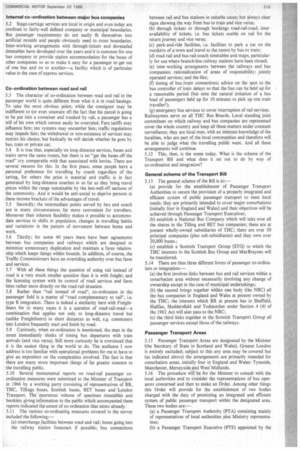Co - ordination between road and rail
Page 219

If you've noticed an error in this article please click here to report it so we can fix it.
5.3 The character of co-ordination between road and rail in the passenger world is quite different from what it is in road haulage. To take the most obvious pdint; while the consignor may be indifferent to (or even unaware of) the fact that his parcel is going to be put into a container and trunked by rail, a passenger has a will of his own which cannot easily be overruled. Fare tariffs may influence him; tax systems may encumber him; traffic regulations may impede him; the withdrawal or non-existence of services may restrict his choice; but basically he will decide whether he goes by bus, train or private car.
5.4 It is true that, especially on long-distance services, buses and trains serve the same routes, but there is no "get the buses off the road" cry comparable with that associated with lorries. There are several reasons for this. In the first place, some people have a personal preference for travelling by coach regardless of the saving, for others the price is material and traffic is in fact generated by long-distance coaches in so far as they bring travel prices within the range sustainable by the less-well-off sections of the community. And it would be anti-social to deprive persons in these income brackets of the advantages of travel.
5.5 Secondly; the intermediate points served by bus and coach are in many circumstances far more convenient for travellers. Moreover their inherent flexibility makes it possible to accommodate services to shifts in population, changes in travelling habits and variations in the pattern of movement between home and work.
5.6 Thirdly; for some 40 years there have been agreements between bus companies and railways which are designed to minimize unnecessary duplication and maintain a fares relationship which keeps things within bounds. In addition, of course, the Traffic Commissioners have an overriding authority over bus fares and services.
5.7 With all these things the question of using rail instead of road is a very much smaller question than it is with freight; and the licensing system with its control of road services and fares bites rather more directly on the road-rail situation.
5.8 Rather than "rail instead of road", co-ordination in the passenger field is a matter of "road complementary to rail", i.e. type B integration. There is indeed a similarity here with Freightliners for in many cases it is a question of road-rail-road—a combination that applies not only to long-distance travel but (unlike Freightliners) to short distances as well, e.g. commuters into London frequently start and finish by road.
5.9 Curiously, when co-ordination is mentioned, the man in the street immediately thinks of timing bus departures with train arrivals (and vice versa). Still more curiously he is convinced that it is the easiest thing in the world to do. The audience I now address is too familiar with operational problems for me to have to give an exposition on the complexities involved. The fact is that there are many more important things of far greater concern to the travelling public.
5.10 Several monumental reports on road-rail passenger coordination measures were submitted to the Minister of Transport in 1966 by a working party consisting of representatives of BR, THC, Tillings buses, Scottish buses, BET buses and London Transport. The enormous volume of specimen timetables and booklets giving information to the public which accompanied these reports indicated the extent of co-ordination that exists already. 5.11 The various co-ordinating measures covered in the survey included the following:—
(a) interchange facilities between road and rail; buses going into the railway station forecourt if possible; bus connections between rail and bus stations in suitable cases; but always clear signs showing the way from bus to train and vice versa; (b) through tickets or through bookings road-rail-road; interavailability of tickets, i.e. bus tickets usable on rail for the return journey and vice versa; (c) park-and-ride facilities. i.e. facilities to park a car on the outskirts of a town and travel to the centre by bus or train; (d) road-rail and bus-rail-coach timetables and maps, particularly for usp where branch-line railway stations have been closed; (e) inter-working arrangments between the railways and bus companies; rationalization of areas of responsibility; jointly operated services; and the like; (f) timing of bus /train connections; advice on the spot to the bus controller of train delays so that the bus can be held up for a reasonable period (but note the natural irritation of a bus load of passengers held up for 10 minutes to pick up one train traveller!);
(g) emergency bus services to cover interruption of rail services. Railwaymen serve on all THC Bus Boards. Local standing joint committees on which railway and bus companies are represented cover the whole country and keep all these matters under constant surveillance; they are local men, with an intimate knowledge of the localities, who are part of the local communities and therefore will be able to judge what the travelling public want. And all these arrangements will continue.
5.12 This, then, is the scene today. What is the scheme of the Transport Bill and what does it set out to do by way of co-ordination and integration'?


















































































































































































































































































































































































